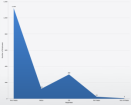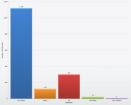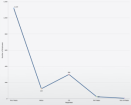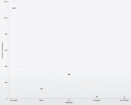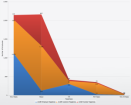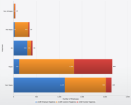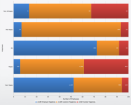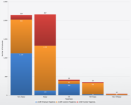Configuring and managing advanced components
NightWatchman Enterprise provides a number of advanced features that deal with specific scenarios and limitations. The following sections provide details on each of the features.
Configuring the 1E NightWatchman Agent
The NightWatchman Agent has four key areas that can be managed:
Scheduling power-offs
Defining the actions taken to log-off a user
Creating or modifying power-off scripts
Setting the actions taken to power-off the machine
As the administrator, you can schedule the system to shut down at a certain time on certain days of the week. You, or the end-user, can also request an immediate power-off.
If there are users logged on the system when a power-off is initiated, the log-off action takes place. If not, NightWatchman proceeds directly to the power-off stage.
Note
If a computer is already in standby or hibernate mode, it will not be woken to shut it down.
There are three log-off modes that can be set:
Passive – if users are logged on, no attempt will be made to shut down.
Active – users are asked if the power-off is allowed to continue.
Force – users are notified that a power-off is about to take place and will be logged off once the countdown expires.
You can set a countdown for a power-off, so in Active and Force modes, users see a countdown to the event. In Active mode, the user has the option to cancel the power-off or enable the event by clicking OK. If the user postpones the event, NightWatchman can be set to retry again later.
If the modes are Active or Force, NightWatchman runs the power-off scripts. The four scripts which enable administrators to power down computers are:
To learn more about scripting NightWatchman, see configuring NightWatchman scripts and scripting reference.
NightWatchman power schemes and reporting data
NightWatchman automatically configures the power scheme to enable processor speed and voltage to vary automatically with system usage, specifically for machines using Intel speed step processors or AMD Cool n' Quiet processors. This results in enhanced energy saving on machines with low average utilization (most office productivity machines). On Windows 7, this involves the creation of a new NightWatchman power scheme based on the Balanced Power Scheme.
From the point of installation, NightWatchman reports inventory and power state data for its local computer back to the reporting server. The inventory information includes:
the computer name
the computer's domain
IP address and subnet
its network card MAC Address
the chassis model, type and manufacturer.
Power state data shows how long the computer is in a particular power state and is used in conjunction with associated typical power consumption information to calculate how much power the computer is consuming throughout the day. Inventory information helps identify the computer and determine any information related to its type, such as its typical power consumption figures.
The NightWatchman Management Center Console lets you define:
Location groups – enables you to model your company according to the physical location of the computers. You can report on and apply location specific power settings to computers according to where they reside. For example, if you know of a forthcoming national holiday, you can apply a one-off policy that sets particular power settings for that specific location only. You can also use these groups to apply specific localized tariffs that increase the accuracy of power cost reports.
Organization groups – enables you to model your company according to organizational units. You can report on and apply specific power settings to computers according to where they sit in the organization. For example, if you know of an off-site team building exercise for a particular department, you can apply a one-off policy that sets particular power settings for that department only.
NightWatchman pre-event tests
When a scheduled power-down event is triggered (and before the Hibernate, Standby, power-off or Reboot events starts), NightWatchman runs the following tests:
Test | Description |
|---|---|
Passive | If |
Last man standing | Check to see if the computer is set to be last man standing. If so, cancel the scheduled event. NoteWindows only test. |
User activity | Check for user activity, If found, cancel the scheduled event. This test is not performed if:
|
Exception list | Check to see if any processes on the process exception list are currently running. If so, cancel the scheduled event. |
Configuration Manager running jobs | If Configuration Manager client exists and NoteIf the computer is a laptop running on batteries, this test is by-passed and the scheduled event is allowed to proceed regardless. |
Configuration Manager pending jobs | If Configuration Manager client exists and NoteIf the computer is a laptop running on batteries, this test is by-passed and the scheduled event is allowed to proceed regardless |
Nomad in-progress file transfers | Check to see if the computer is acting as the Nomad P2P master. If so, cancel the scheduled event. |
Nomad PBA content found | Check to see if the computer has content that Nomad is holding as part of its Peer-Backup Assistant functionality. If so, cancel the scheduled event. |
Keep active status | Check the Keep Active status on the NightWatchman user interface. If set, cancel the scheduled event. |
Active maintenance window | If a NightWatchman maintenance window is active, cancel the scheduled event. |
Because the 1E Agent will cancel a scheduled power down event when there are pending or running Microsoft Configuration Manager jobs, it is recommended to set logoffaction=FORCE when attempting to power down a computer after successfully running a Configuration Manager software distribution Advertisement.
An alternative would be to use the NightWatchman command-line and set a once-off power down with logoffaction set to ACTIVE or PASSIVE to power down the computer at a specific time and let it retry until the Advertisement has finished running.
NightWatchman events
The following takes place when a NightWatchman event is triggered.
Event | Sequence |
|---|---|
Hibernate or stand-by |
|
Power-off or reboot |
|
Resume from a low-power state |
|
To learn how to configure NightWatchman or modify its scripts, see configuring NightWatchman. To learn about the switches that control NightWatchman functionality, see command-line switches.
End-user actions
When you enable the NightWatchman system tray interface, the end-user can:
Keep their computer active by opting out of passive or active NightWatchman power-offs for a period of time.
Initiate a local power-off.
View the list of files backed-up during the last log-off process.
You may also want to audit end-user interaction with the NightWatchman backup dialog and resolve issues with backups that occasionally do not appear in the backup list. The 1E Agent tracks basic end-user choices when selecting the Save or Reject options in the Backup Dialog.
For each file that the user chooses to accept or reject, an entry is added to NWMAudit.log, which is created in the per-user NightWatchman data folder. for example, C:\Users\joey.malloy\AppData\Local\1E\NightWatchman.
Each entry indicates the time of the operation, the original document name, whether the user chose to Keep or Reject the file and, where applicable, the name of the file that the backup was saved to.
Configuring NightWatchman scheduled actions from the command-line
You can set different power down times on different days of the week using different power down and log-off actions. The previously used switches: shutdowndays, shutdowntime, shutdownaction and logoffaction are still supported but we recommend moving to the new enhanced syntax at your earliest convenience.
The following examples illustrate scheduledactions in practice. Note the slight differences between in syntax for Windows computers and Mac. The command-lines are broken down to separate rows for clarity – they are executed as single line.
Event | Command-line |
|---|---|
Power off a machine with a logoffaction of force everyday at 18:00 | Windows: NightWatchman.exe –scheduledactions="ALLDAYS(18:00,PowerOff,Force)" Mac: sudo ./NightWatchman –scheduledactions ALLDAYS=18:00,PowerOff,Force |
Power off a machine with a logoffaction of force on weekdays at 18:00 and a passive log-off and hibernate at 1300 during the weekends | Windows: NightWatchman.exe –scheduledactions="WEEKDAYS(18:00,PowerOff,Force) | WEEKEND(13:00,Hibernate,Passive)" Mac: sudo ./NightWatchman –scheduledactions WEEKDAYS=18:00,PowerOff,Force WEEKEND=13:00,Hibernate,Passive |
Power off a machine with a logoffaction of force on Mondays and Tuesdays, passive log-off and standby at 20:00 on Wednesdays and an active hibernate at 17:00 on Thursday and Fridays | Windows: NightWatchman.exe –scheduledactions="MON,TUE(18:00,PowerOff,Force)| WED(20:00,Standby,Passive)| THU,FRI(17:00,Hibernate, Active)" Mac: sudo ./NightWatchman –scheduledactions MON,TUE=18:00,PowerOff,Force WED=20:00,Standby,Passive THU,FRI=17:00,Hibernate,Active |
Clear all daily power off events | Windows: NightWatchman.exe –scheduledactions="OFF" Mac: sudo ./NightWatchman –scheduledactions |
Managing client groups
By supporting the construction and manipulation of location and organization client group hierarchies, NightWatchman Console lets you model your business appropriately. The groups can be used to enables the application of power policies to business units or locations, not just specific computers. To learn more about applying power policies, see using the NightWatchman group hierarchies.
Using NightWatchman Console you can:
Reporting
Location and organization groups can be used in the NightWatchman Agility Framework reports to enable power consumption statistics to be analyzed in terms of their effect on the business. To learn more about reporting, see the NightWatchman Management Center Reporting Guide .
Adding groups
To add a group:
Select either the Location Groups or Organization Groups tab.
Select an existing node in the Groups tree for the new group to be under.
Right-click the node and from the context menu, choose Add Group...
Enter the name for the new group in the Add Group dialog and click OK. The new group appears under the previously selected group node.
Renaming groups
To rename a group:
Select the group node to rename.
Right-click the group node and select the Rename Group option from the context menu.
The group name will turn into an edit field, type in the new name.
Click Enter to accept the change or ESC to cancel.
Deleting groups
To delete a group:
Select the group node to delete.
Right-click the group node and on the context menu, choose Delete.
You are prompted to confirm your actions. Click Yes to confirm or No to cancel. If you previously ticked the Don't ask me again checkbox, you will not be prompted and the group is removed from the NightWatchman Console immediately.
As a precaution, NightWatchman Console prevents the deletion of groups that contain sub-groups.
When a building node gets deleted computers associated with it are reassigned to the UNASSIGNED BUILDING group. Similarly, when a department node gets deleted, computers associated with it are reassigned to the UNASSIGNED DEPARTMENT group.
Note
When groups are deleted, their records persists in the the database but are marked as deleted (soft-delete) and is not displayed in the Nightwatchman Console. Computers associated with that group are re-classified as UNASSIGNED. Reporting data for the deleted groups are not affected.
Assigning computers to departments and buildings
To assign or move computers to specific departments and buildings:
Computers cannot be moved between the Location and Organization group hierarchies. Select which hierarchy you want to modify by clicking either the Location Groups or Organization Groups tab.
In the Groups tree, navigate to the current location of the computers you want to assign. Unassigned computers reside in the UNASSIGNED BUILDING node for Location groups and UNASSIGNED DEPARTMENT for Organization groups.
Select the computers to move to a particular department or building.
Scroll the Groups tree view and expand nodes until the department or building node is visible.
Drag your selection into the new department or building node. You can only drag computers to a building or department group, i.e. one that is at the fifth tier of the organization or location hierarchies.
Removing computers from departments and buildings
To remove computers from specific departments and buildings:
In the Groups tree view, navigate to the building or department you want to remove computers from.
Select the computers to remove.
Right-click and from the context menu, choose Remove from Group.
The selected computers are disassociated from their current node and reassigned the UNASSIGNED BUILDING group or the UNASSIGNED DEPARTMENT group.
Configuring ASP.NET for Windows Server 2012 R2
To configure ASP.NET (must be ASP.NET 4.5 for FIPS compliance) for Windows Server 2012 R2:
Start Server Manager.
From the Manage menu (top-right menu bar), select Add Roles and Features.
On the Before you begin, page click Next.
On the Installation Type page, ensure Role-based or feature-based installation is selected and click Next.
On the Server Selection page, ensure the local server is selected and click Next.
On the Server Roles page, check the Web Server (IIS) server role.
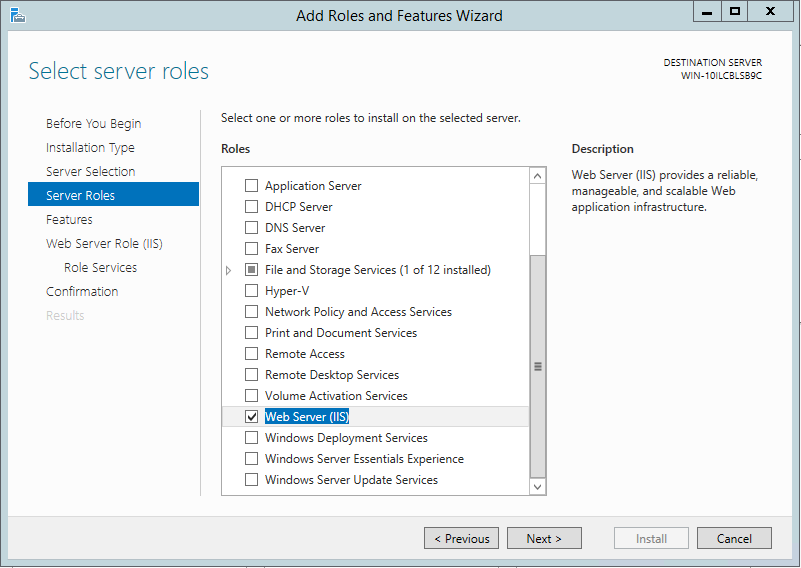
In the dialog, click Add Features to add the features required for Web Server (IIS).
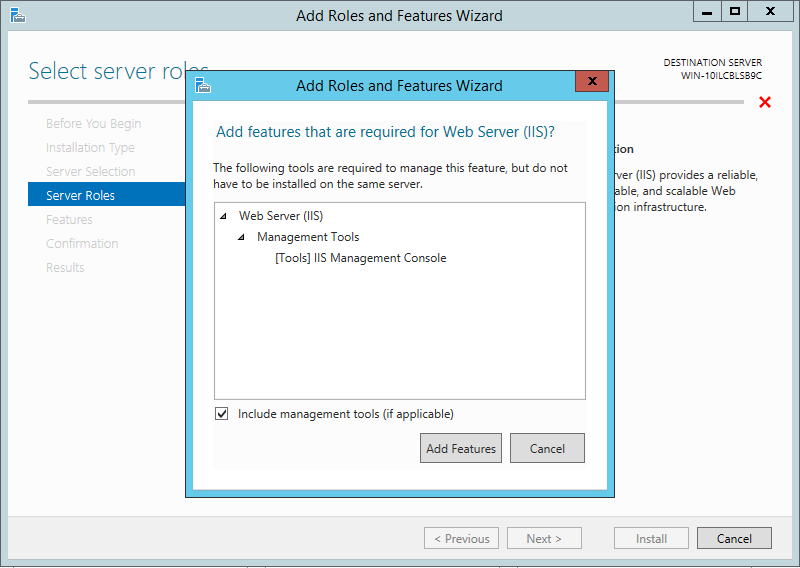
The Web Server Role (IIS) page is added after the Web Server (IIS) is checked on the Server Roles page.
On the Role Services page under Web Server Role (IIS), expand the Security node and check Windows Authentication.
Expand Application Development and check the ASP.NET 4.5 node (this also checks a number of other options, such as ISAPI Extensions and ISAPI Filters).
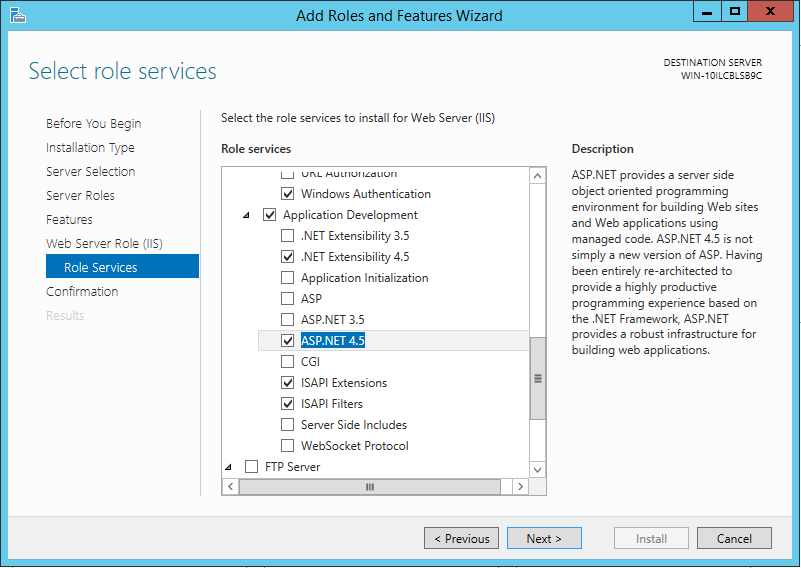
When you select ASP.NET 4.5 you will be prompted to add features related to that role. Click Add Features in the dialog to add all the features.
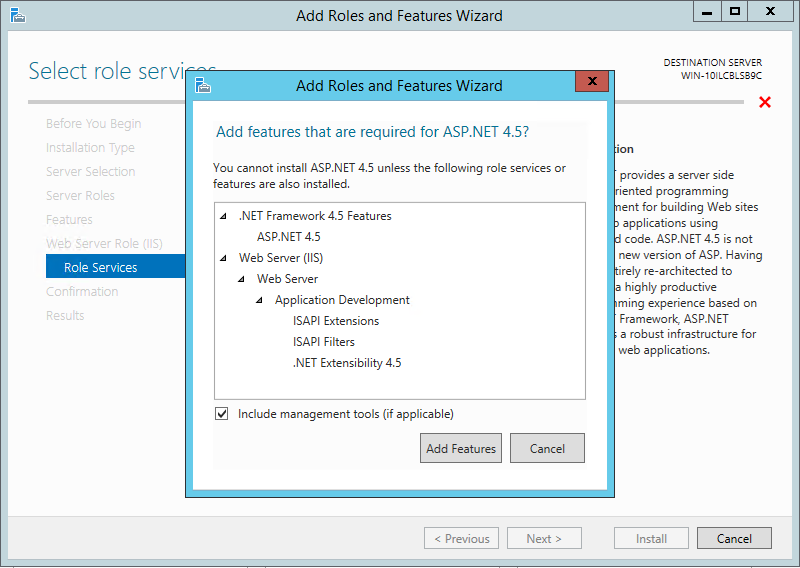
After you have made the necessary changes, click Install to begin the role installation. Installation progress is displayed while the components are being installed.
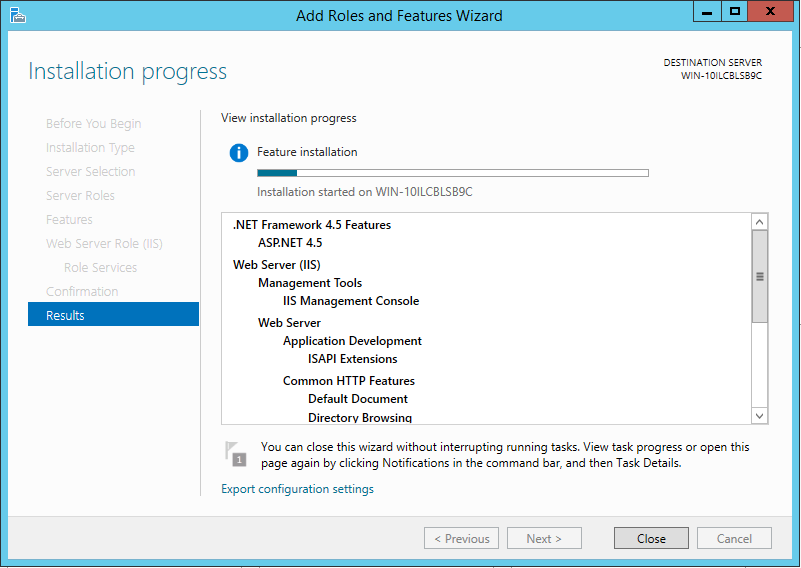
Customizing Enterprise View
To illustrate how to customize Enterprise View, we are going to show you how to get the data from a database and display it as a chart as well as a table. Our example (ACME Corporation) uses a database that holds employee, customer and investor satisfaction ratings – the Happy table contains the following columns and data:
Happy states | Employees | Customers | Investors |
|---|---|---|---|
Ecstatic | 543 | 123 | 58 |
Extremely Happy | 400 | 700 | 158 |
Happy | 390 | 323 | 89 |
Mildly Unhappy | 243 | 23 | 58 |
Extremely Unhappy | 143 | 12 | 38 |
Outraged | 0 | 1 | 4 |
Note
Enterprise View ships with a set of XSD (XML schema defintion) files, which can be used when customizing tiles to validate the content and structure of the tile definition.
Displaying data as a chart
To display your data as a chart:
Define an SQL data source in the
DataSources.xmlfile located in the Enterprise View\Dashboard.Web\Source folder.<DataSource Name="ACME"> <ConnectionProperties DataProvider="SQL"> <Value> <![CDATA[Server=(local); Database=ACME; Trusted_Connection=True; pooling=false]]> </Value> </ConnectionProperties> </DataSource>Create a tile definition XML file in the
EnterpriseView\Dashboard.Web\Source\Tilesdirectory and add aDashboardTileelement with command and presentation sections, the namespace used for the components and other attributes for the tile. For example, we create the following XML tile definition to display:
<?xml version="1.0" encoding="unicode" ?> <DashboardTile xmlns="http://www.1e.com/2009/DashboardTile.xsd" xmlns:chart=http://www.1e.com/2009/StandardChart.xsd Type="Standard" Title="ACME Happy Tile" ThumbnailSource="columnchart.png" Description=" The ACME employees, customers and investors happiness index" RefreshFrequencyMins="60" Activator="StandardChartActivator">where:
Typemust be Standard for all user-defined tilesTitleis the label for the tileThumbnailSourceis the location of image for the tileDescriptionis a description for the tileRefreshFrequencyMinsis the interval to refresh the tile – 60 minutes in our exampleActivatorisStandardChartActivatorwhich tells Enterprise View to retrieve the data in the correct format for the chart presentation
Create the query to retrieve data for the chart. In our example, (ACME datasource, defined in step 1) the ACMESAT identifier is used in the presentation section.
<CommandCollection> <Command DataSource="ACME" Identifier="ACMESAT"> <Text><![CDATA[SELECT Happiness, Employees, Customers, Investors FROM dbo.Happy]]></Text> </Command> </CommandCollection>You can have one or more commands each defined in the
<Command></Command>.Note
SQL data sources can also be used to run stored procedures to retrieve the required data, which is generally safer than running arbitrary SQL.
We are going to chart the number of people and their ratings for ACME Corporation using a series for each of the Employees, Customers and Investors data:
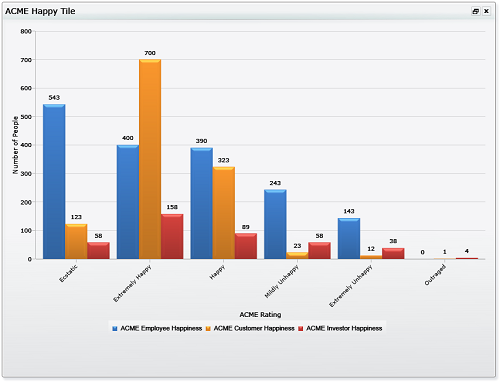
<Presentation> <chart:StandardChart LegendEnabled="true" AxisYTitle="Number of People" AxisXTitle="ACME Rating"> <chart:SeriesCollection> <chart:Series Type="Column" LabelEnabled="true" LegendText="ACME Employee Happiness"> <chart:DataPoint CommandIdentifier="ACMESAT" YValueBinding="Employees" AxisXLabelBinding="Happiness"/> </chart:Series> <chart:Series Type="Column" LabelEnabled="true" LegendText="ACME Customer Happiness"> <chart:DataPoint CommandIdentifier="ACMESAT" YValueBinding="Customers" AxisXLabelBinding="Happiness"/> </chart:Series> <chart:Series Type="Column" LabelEnabled="true" LegendText="ACME Investor Happiness"> <chart:DataPoint CommandIdentifier="ACMESAT" YValueBinding="Investors" AxisXLabelBinding="Happiness"/> </chart:Series> </chart:SeriesCollection> </chart:StandardChart> </Presentation>The Y axis is labeled Number of People and the X axis ACME Rating. The chart uses the Column type.
The ACMESAT identifier (defined in step 3) is used to retrieve the data, with the Y value binding set to the Employees, Customers and Investors columns for each series and the X value set to the Happiness rating
The legend for each series is set to ACME Employee Happiness, ACME Customer Happiness and ACME Investor Happiness respectively.
Displaying data in a table
To display your data in a table:
Typemust be Standard for all user-defined tablesTitleis the title for the tableThumbnailSourceis the location of image for the tableDescriptionis a description for the tableRefreshFrequencyMinsis the interval to refresh the table – 60 minutes in our exampleActivatorisStandardListViewActivatorwhich tells Enterprise View to retrieve the data in the correct format for the table presentation
We are going to use the data source you prepiously created for the chart.
Create the table definition XML file in the
EnterpriseView\Dashboard.Web\Source\Tilesdirectory and add aDashboardTileelement with command and presentation sections, the namespace used for the components and other attributes for the tile.<?xml version="1.0" encoding="unicode" ?> <DashboardTile xmlns="http://www.1e.com/2009/DashboardTile.xsd" xmlns:res="http://www.1e.com/2009/DashboardResources.xsd" xmlns:para="http://www.1e.com/2009/StandardParagraph.xsd" xmlns:table="http://www.1e.com/2009/StandardTable.xsd" Type="Standard" Title="ACME Happy Table" ThumbnailSource="table.png" Description="This table lets you know the ACME approval rating!" RefreshFrequencyMins="60" Activator="StandardListViewActivator">where:
Create the query to retrieve data from the table. We are going to use the query already created for the chart.
We are going to display the data for the number of people and their ratings for ACME Corporation using a columns and rows:
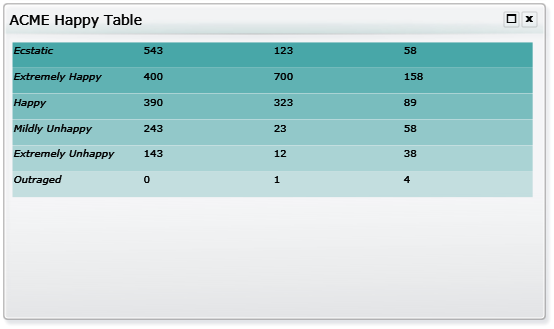
Creating a table
The following example sets the namespaces required for a table tile.
The type for all user-defined tiles must be set to Standard.
The title that appears on the banner for the tile and on the tile configuration page is set to ACME Happy Table.
The thumbnail and description that appear on the tile configuration page are set to
table.pngand a suitable description for the tile.The
RefreshFrequencyMinsis set to 60 so the tile will be updated every hour.The activator is set to the
StandardListViewActivatorwhich tells Enterprise View to retrieve the data from the data sources in the correct format for the table presentation type.
<?xml version="1.0" encoding="unicode" ?>
<DashboardTile xmlns="http://www.1e.com/2009/DashboardTile.xsd"
xmlns:res="http://www.1e.com/2009/DashboardResources.xsd"
xmlns:para="http://www.1e.com/2009/StandardParagraph.xsd"
xmlns:table="http://www.1e.com/2009/StandardTable.xsd"
Type="Standard"
Title="ACME Happy Table"
ThumbnailSource="table.png"
Description="This table lets you know the ACME approval rating!"
RefreshFrequencyMins="60"
Activator="StandardListViewActivator">Commands
The example can use exactly the same command used in the previous chart tile example.
<CommandCollection>
<Command DataSource="ACME" Identifier="ACMESAT">
<Text><![CDATA[SELECT Happiness, Employees, Customers, Investors FROM dbo.Happy]]></Text>
</Command>
</CommandCollection>Presentation
The <Presentation> tag this time contains a single <table:StandardTable> definition, where table is an object name declared in a namespace definition in the tile's <DashboardTile> tag. The <table:ColumnCollection> tag defines general parameters for the table and holds the individual <table:Column> tag definitions.
The <table:ColumnCollection> tag sets the ACMESAT command to populate the table, turns off displaying of the column headings and sets the background color for the table to a green/blue color.
Note
The ShowColumnHeader parameter is set to false. In this version the column headings do not support text formatting so it is usually best to not display them.
<Presentation>
<table:StandardTable >
<table:ColumnCollection CommandIdentifier="ACMESAT"
ShowColumnHeader="false"
BackgroundColor="#FF008888">The following <table:Column> tag sets the data that will be displayed in the column using the Binding parameter. It also sets the column title, the column width and height and the height of the column heading.
The type of the column is set to html this allows HTML formatting to be applied to the contents of the column using the <table:FormatString> tag.
The Happiness binding is referenced in the format string using the {parameter} syntax. This substitutes the value for the binding into that location in the format string so in this example the column will display the Happiness value with a font size of 24 and with the emphasis style.
The CDATA syntax is used to allow the format string to contain characters that would normally require escape characters in XML.
<table:Column Binding="Happiness"
Title="Happy"
Width="300" ContentHeight="60" Type="html">
<table:FormatString>
<![CDATA[<font size="24"><em>{Happiness}</em></font>]]>
</table:FormatString>
</table:Column >The following column definitions complete the table column collection.
<table:Column Binding="Employees" Title="Employees" Type="html" Width="300" ContentHeight="60" >
<table:FormatString>
<![CDATA[<font size="24">{Employees}</font>]]>
</table:FormatString>
</table:Column >
<table:Column Binding="Customers" Title="Customers" Type="html" Width="300" ContentHeight="60" >
<table:FormatString>
<![CDATA[<font size="24">{Customers}</font>]]>
</table:FormatString>
</table:Column >
<table:Column Binding="Investors" Title="Investors" Type="html" Width="300" ContentHeight="60" >
<table:FormatString>
<![CDATA[<font size="24">{Investors}</font>]]>
</table:FormatString>
</table:Column >
</table:ColumnCollection>In this example we also include a <StandardParagraph> tag that will display some descriptive text when the tile is maximized. This tag must be placed inside the <table:StandardTable> tag and only one is allowed.
<para:StandardParagraph>
<para:Paragraph>
<![CDATA[This table shows the happiness factor for the ACME corporation from the perspective of employees, customers and investors.]]>
</para:Paragraph>
</para:StandardParagraph>
</table:StandardTable>
</Presentation>
</DashboardTile>Using the same data as in the previous chart example, this table definition results in the tile.
 |
Creating new Enterprise View tiles
Enterprise View is a customizable dashboard where users can go and set up their own customized page showing the information being collected by the 1E products. Enterprise View tiles are defined using a set of XML files located at:
%installdir%\1E\EnterpriseView\Dashboard.Web\Source\
All files should end with the extension .xml and are validated by a set of XML schemas located at:
%installdir%\1E\EnterpriseView\Dashboard.Web\Source\Schemas
Specifying a data source
The tiles require data sources to display anything useful. The data sources must be added to the DataSources.xml file in the Enterprise View\Dashboard.Web\Source directory. By default the DataSources.xml file contains four data sources: Dashboard, NightWatchman, NightWatchmanServer and LOCAL.
The Dashboard data source relates to the Enterprise View settings, the NightWatchman and NightWatchmanServer relate to the data held by NightWatchman Management Center and NightWatchman Server Edition products. The fourth default data source called LOCAL refers to a local directory where you can store and retrieve XML data.
Data source types
There are two data source types, SQL and XML. XML data sources refer to XML format files held locally in the Enterprise View\Dashboard.Web\Source\LocalData directory. SQL data sources must have their SQL connection information defined.
Using your own database
If the database you are using as a data source is local to the Enterprise View website you need to add NT AUTHORITY/NETWORK SERVICE to the database users and grant that account the appropriate permissions for any specific tables you want to use in the database.
If the data source database is remote you need to add the machine account for the computer hosting the Enterprise View website. This will be in the format <DOMAIN> <MACHINENAME>$ where the <DOMAIN> is the domain where the host computer is running and <MACHINENAME> is the name of the computer hosting the Enterprise View website.
For example, given a server called ACMESVR030 running on the domain ACME, you need to add the following machine account as a user on the database:
ACME\ACMESVR030$
Creating an SQL data source
When creating an SQL data source, you need to specify the connection string to the database. This includes the server name, the database and configuration settings for the connection.
For example to create a data source for an ACME database residing locally to the Enterprise View website you would add the following to the DataSources.xml file as a new element of the DataSources element.
<DataSource Name="ACME">
<ConnectionProperties DataProvider="SQL">
<Value>
<![CDATA[Server=(local);Database=ACME;Trusted_Connection=True;pooling=false]]>
</Value>
</ConnectionProperties>
</DataSource>The XML LOCAL data source
If you want to use an XML file as the input data source for a tile, use the LOCAL data source already defined. All data files should reside in the folder, relative to the Enterprise View installation directory:
Enterprise View\Dashboard.Web\Source\LocalData
When specifying the command in the tile using the LOCAL data source, give the name of the file (see above) containing the data.
Defining an XML data file
The XML data file needs to obey the following format. The file must start with the xml version and encoding tag:
<?xml version="1.0" encoding="utf-8"?>
There must be a single <Result></Result> tag which contains all the rows of data. Each row of data must appear in a <Row> tag. Each column in the row must be defined as a number of column/value pairs separated by spaces in the following format:
ColumnName1="Value1" ColumnName2="Value2"
For example, the following shows an XML data file representing a four column data table where the columns are named Id, Month, PCSaving and ServerSaving.
<?xml version="1.0" encoding="utf-8"?> <Result> <Row Id="0" Month="Sep 09" PCSaving="25399.00" ServerSaving="2500"/> <Row Id="1" Month="Oct 09" PCSaving="23872.00" ServerSaving="2389"/> <Row Id="2" Month="Nov 09" PCSaving="24977.00" ServerSaving="2700"/> <Row Id="3" Month="Dec 09" PCSaving="24293.00" ServerSaving="3214"/> <Row Id="4" Month="Jan 10" PCSaving="24556.00" ServerSaving="2847"/> <Row Id="5" Month="Feb 10" PCSaving="25675.00" ServerSaving="2837"/> </Result>
XML format tile definition file
The contents of the tile definition file must start with the xml version and encoding tag:
<?xml version="1.0" encoding="unicode" ?>
DashboardTile tag
The tile definition must be placed in the <DashboardTile></DashboardTile> tag. The attributes for this tag lets you define general attributes for the tile, including the schemas for any presentation elements the tile definition uses and the tile's title, description and type. The following parameters can be set in the DashboardTile tag:
Parameters | Notes |
|---|---|
Activator | The activator specifies how data is actively retrieved for the tile. Each activator corresponds to the tile presentation elements that will be used in the tile. There are four supported activators to choose from but only one can be set per tile. The activators and corresponding presentation elements are:
|
Description | Description for the tile as it appears in the configuration page of the Enterprise View website. |
RefreshFrequencyMins | Duration (in minutes) between refreshing the data in the tile. |
ThumbnailSource | Icon for the tile as it appears in the configuration page of the Enterprise View website. |
Title | Title for the tile as it appears at the top of the tile and on the configuration page of the Enterprise View website. |
Type | Must be Standard to enable the supported presentation elements described below. |
xmlns:<object> | The schema definitions that are required to allow particular components to be used in a tile definition. Each xmlns:res="http://www.1e.com/2009/DashboardResources.xsd" to the <res:ResourceDictionary Language="en-US"> |
Tile commands
Each tile command is used to gather information from a particular data source. You can have a number of commands defined in a single command collection each referring to the same or a different data source. All the commands must be placed in a single <CommandCollection></CommandCollection> tag, usually as the first element inside the DashboardTile tag.
The command definition must provide the name for a data source defined in the DataSources.xml file and an identifier that will be used to run the command in a presentation element. The command identifier must be unique within the tile definition but this is not checked by Enterprise View – you will need to ensure this is the case.
Each command must be defined using the <Command></Command> tag using the following format:
<Command DataSource="DataSourceName" Identifier="CommandID">
<Text>
Command...
</Text>
</Command>where DataSourceName and CommandID is the data source and command identifier respectively and Command... is the command to run.
SQL commands
It is usual, though not required, to put the command definition in a CDATA statement. This allows XML reserved characters to be used in the command without the need for escape characters.
For example, the following command uses the ACME data source and selects the Rating and Number columns from the dbo.UserSatisfaction table in the database the ACME data source references. The command would then be used in a presentation element by referring to the ACMECMD identifier.
<Command DataSource="ACME" Identifier="ACMECMD">
<Text>
<![CDATA[ SELECT Rating, Number FROM dbo.UserSatisfaction ]]>
</Text>
</Command>XML commands
These commands always use the LOCAL XML data source and the command definition always consists of the name of the file containing the required data.
For example, the following command references the DepartmentCost.xml file which must be located in the LocalData directory. The command is then used in a presentation element by referring to the DEPTCOST identifier.
<Command DataSource="LOCAL" Identifier="DEPTCOST"> <Text>DepartmentCost.xml</Text> </Command>
Configuring tile presentation elements
To use any of the tile presentation elements you must include a reference to its schema in the DashboardTile element as follows:
Standard tables – http://www.1e.com/2009/StandardTable.xsd
Standard paragraphs – http://www.1e.com/2009/StandardParagraph.xsd
Standard charts – http://www.1e.com/2009/StandardChart.xsd
Standard single vales – http://www.1e.com/2009/StandardSingleValue.xsd
Standard tables
When using the table presentation element, include the following namespace definition in the DashboardTile element. The table definition in the presentation section uses the table object name:
xmlns:table="http://www.1e.com/2009/StandardTable.xsd"
The outer element for a table definition is <table:StandardTable></table:StandardTable> all other atrributes must be placed inside this. The columns for the table definition must be placed within <table:ColumnCollection></table:ColumnCollection>. The following attributes can be set for ColumnCollection:
Attributes | Default value | Notes |
|---|---|---|
ShowColumnHeader | Determines whether a header row is displayed for the table. Values are:
| |
CommandIdentifier | The command to use to populate the table. | |
BackgroundColor | Background color for the table in XAML color format: #OPRRGGBB where OP sets the color's opacity, RR, GG and BB sets the red, green and blue values respectively. For example, to set the background colour to green: BackgroundColor="FF00FF00" |
Inside <table:ColumnCollection>, add the <table:Column> attributes that define the actual contents of the table. The following attributes can be set for Column:
Attributes | Default value | Notes |
|---|---|---|
Type | Sets the format of the contents. See Enterprise View Image Resources for a list build-in images and Supported HTML 4 tags for further details. Values are:
| |
Width | Width for the column. | |
Title | Column title. This can be used to set the title directly instead of defining TitleCommandIdentifier and TitleBinding. NoteTitle takes precedence over TitleBinding. | |
TitleCommandIdentifier | Command to be used to determine the column's title. | |
TitleBinding | Binding from the command set in TitleCommandIdentifier to be used as the column's title. | |
TitleHeight | Row height. Title also sets the font size to be used for the header row. | |
ContentHeight | Height for the contents rows for the column. |
Standard paragraphs
You can place a single standard paragraph in either the StandardTable or the StandardChart element. It must be placed inside the element but outside the ColumnCollection or SeriesCollection. The paragraph uses a limited subset of HTML 4 for formatting the text. See Supported HTML 4 tags for further details.
Standard charts
When using the table presentation element you could include the following namespace definition in the DashboardTile element, the table definition in the presentation section uses the table object name:
xmlns:chart="http://www.1e.com/2009/StandardChart.xsd"
The outer element for a chart definition is <chart:StandardChart></chart:StandardChart> all other chart attribute are placed within this. The following attributes can be set for StandardChart:
Attributes | Default value | Description |
|---|---|---|
AxisYTitleCommandIdentifier | This must be set to a command that will retrieve the data for the chart. | |
LegendEnabled | Shows or hides the legend identifying each data series on a chart. Values are:
| |
AxisXTitle | Text for the X Axis title. AxisXTitle overrides AxisXTitleCommandIdentifier and AxisXTitleCommandBinding . | |
AxisXTitleCommandIdentifier | The X Axis title. Used in conjunction with AxisXTitleCommandBinding . | |
AxisXTitleCommandBinding | The X Axis title. AxisXTitleCommandBinding is retrieved from the results of AxisXTitleCommandIdentifier . | |
AxisYTitle | The Y Axis title. AxisYTitle overrides AxisYTitleCommandIdentifier and AxisYTitleCommandBinding . | |
AxisYTitleCommandIdentifier | The Y Axis title. Used in conjunction with AxisYTitleCommandBinding . | |
AxisYTitleCommandBinding | The Y Axis title. AxisYTitleCommandBinding is retrieved from the results of AxisYTitleCommandIdentifier . |
All the data series required for the chart should be placed inside the <chart:SeriesCollection></chart:SeriesCollection> element. Each data series is defined using <chart:Series></chart:Series>. The following attributes can be set for Series:
Attributes | Default value | Description |
|---|---|---|
AxisXFormatString | The format for AxisXLabelBinding . | |
AxisXLabelBinding | Must be bound to a value returned by CommandIdentifier . | |
CommandIdentifier | Sets a command that will retrieve the data for the series. | |
Color | The color for the chart series. | |
YValueBinding | Must be bound to a value returned by CommandIdentifier . | |
YValueFormatString | The format for the YValueBinding . | |
Type | Must be set to the type of the chart to be used to display the series. | |
LabelEnabled | Shows or hides the label. Values are:
| |
LegendText | Text for the series in the chart legend. | |
Name | Name for the series. |
Chart combinations
It is possible to combine different chart types by using a different chart for each data series. This is subject to the following restrictions:
The Pie and Doughnut charts cannot be combined with each other or any other chart
The Bar, StackedBar and StackedBar100 can be combined with each other but not with any other chart type
Chart types
The following table shows the chart types available for use with Enterprise View. The chart names are case sensitive so you need to be careful with capitalization of the chart names when adding them to the tile definitions.
Chart type | Chart | Notes | |
|---|---|---|---|
Area |
| Displays an area chart. This is a line chart that is filled to the X axis. | |
Bar |
| Displays a bar chart, where the y value for each value of x is shown as a horizontal bar. | |
Column |
| Displays a column chart, where the y value for each value of x is shown as a vertical bar. | |
Doughnut |
| Displays a doughnut chart, where the y value for each distinct value of x is displayed as a sector of a ring. This shows the proportion between the distinct values. | |
Line |
| Displays a line chart, where the y value is plotted against each distinct value for x. | |
Pie | >
| Displays a pie chart, where the y value for each distinct value of x is displayed as a sector of a circle. This shows the proportion between the distinct values. | |
Point |
| Displays a point chart, where the y value is plotted against each distinct value for x. | |
SectionFunnel |
| A section funnel chart is displayed as an inverted pyramid, where the shape of the chart is fixed and the different values are shown as layers inside. This allows the relative sizes of the values to be determined whilst indicating a general importance relationship between the parameters shown at the top and the ones at the bottom. | |
StackedArea |
| The stacked area chart shows each set of y values as area charts stacked above one another. This allows easy visualization of the proportions between the values and how these proportions change with the corresponding x values. | |
StackedArea100 |
| The stacked area 100 chart shows a stacked area chart where each set of y values is adjusted to show the percentage relationship between the individual values. | |
StackedBar |
| The stacked bar chart shows each set of y values as bars stacked beside one another. This allows easy visualization of the proportions between the values and how these proportions change with the corresponding x values. | |
StackedBar100 |
| The stacked bar 100 chart shows a stacked bar chart where each set of y values is adjusted to show the percentage relationship between the individual values. | |
StackedColumn |
| The stacked bar chart shows each set of y values as bars stacked beside one another. This allows easy visualization of the proportions between the values and how these proportions change with the corresponding x values. | |
StackedColumn100 |
| The stacked bar 100 chart shows a stacked bar chart where each set of y values is adjusted to show the percentage relationship between the individual values. | |
StreamLineFunnel |
|
Standard single value
When using the standard single value presentation element you would include the following namespace definition in the DashboardTile element, the definition in the presentation section would subsequently use the value object name:
xmlns:value="http://www.1e.com/2009/StandardSingleValue.xsd"
The only standard single value type currently supported is the Gauge. This takes a single data binding and displays the value on a speedometer. Gauges require that the Activator attribute in the DashboardTile element is set to GaugeActivator.
Single value definitions
The tag for a single value definition is <value:StandardSingleValue></value:StandardSingleValue>. The following attributes can be set in the StandardSingleValue tag:
Attributes | Notes |
|---|---|
CommandIdentifier | The binding for the gauge. |
Binding | Parameter from the command used to set the value for the gauge. |
Type | Currently only the Gauge type is supported. |
MinimumValue | Minimum value for the gauge. |
MaximumValue | Maximum value for the gauge. |
Unit | Text for the units description that appears in the center of the gauge. |
Precision | Precision for the digit display. |
Additional tile settings
By default, Enterprise View tiles are set to not refresh. That is, in order to view any data that has changed in the database or local XML data must refresh or reload the page.
There is an auto-refresh parameter that can be set as part of the tile definition that makes the tile automatically re-run its query to get any new data at a specified interval.
To do this, add the RefreshFrequencyMins parameter to the DashboardTile element.
<?xml version="1.0" encoding="utf-16" ?>
<DashboardTile xmlns="http://www.1e.com/2009/DashboardTile.xsd"
xmlns:table="http://www.1e.com/2009/StandardTable.xsd"
xmlns:res="http://www.1e.com/2009/DashboardResources.xsd"
Title="{Title}"
Description="{Description}" Type="Standard"
Activator="StandardListViewActivator"
ThumbnailSource="table.png"
RefreshFrequencyMins="5">Defining tile permissions
By default, there are no permissions defined. This means that all users have access to Enterprise View. Enterprise View handles tile permissions through definitions for roles and users. The roles are defined with the specific tiles they are able to view and users are then associated with these roles.
Tile access is configured by creating the following file in:
%programfiles%\1E\Dashboard\Dashboard.Web\Source\TileAuthorization.xml
An empty version of the file contains the following:
<?xml version="1.0" encoding="utf-8" ?> <Authorization xmlns="http://www.1e.com/2009/TileAuthorization.xsd"> </Authorization>
Defining Roles
Roles are defined within the <Role> element which has the following attributes:
Attributes | Default value | Notes |
|---|---|---|
Name | The name for the role. Used when defining the users that have the role. | |
Description | A description for the role. | |
DefaultPermission | Allowed | Sets the default permission for the role. Values are:
|
Adding an exception to the role definition counteracts the default permission for the role for a particular tile. You can either leave the default permission for the role as Allowed and define exceptions for tiles where access is denied, or you can set the default permission to Denied and define exceptions where access is allowed.
The following illustrates a definition where Developers have access to all tiles except FirstTile and SecondTile:
<Role Name="Developers" Description="Developers and Technicians Role" > <Exception TileIdentifier="FirstTile"/> <Exception TileIdentifier="SecondTile"/> </Role>
The following illustrates a definition where Developers cannot access any tiles except FirstTile and SecondTile.
<Role Name="Developers" Description="Developers and Technicians Role" DefaultPermission="Denied" > <Exception TileIdentifier="FirstTile"/> <Exception TileIdentifier="SecondTile"/> </Role>
Defining Users
Having defined the roles, you associate them with specific users. This is done with <RoleAccountMapping> which has a single attribute that specifies the role being associated.
Role – set to the name of a previously defined Role name.
Next, you add account definitions for each user you want to associate with the named role. This is done with <Account> which has a single attribute that specifies the user account:
Name – set to the AD account name for the user.
For example, the following sets a user for the Developers role defined earlier:
<RoleAccountMapping Role="Developers"> <Account Name = "ACME\Ned.Zeppelin" /> </RoleAccountMapping>
Globalization
To enable globalization and resources for a particular tile, add the following to the DashboardTile tag:
xmlns:res="http://www.1e.com/2009/DashboardResources.xsd"
The resource dictionary and setter definitions use the object name ref. The resources are defined in <Resources></Resources>. Each collection of language resources are defined in <res:ResourceDictionary></res:ResourceDictionary> which has a single attribute that defines the language code used.
Language – defines the language code. This is matched against the language code used in the browser where the tile is displayed. For example, the following illustrates a resource dictionary for US English:
<res:ResourceDictionary Language="en-US"> …US English setters go here… </res:ResourceDictionary>
The contents of a resource dictionary consist of <res:Setter> entries where you can set the following attributes:
Property – the name used to reference the resource
Value – the value to be substituted where the property name is referenced.
For example, the following illustrates a resource setter for a en-US resource dictionary:
<Resources> <res:ResourceDictionary Language="en-US"> <res:Setter Property="Title" Value="Aluminum" /> </res:ResourceDictionary>
and the following is the equivalent resource for an en-GB resource dictionary:
<Resources> <res:ResourceDictionary Language="en-GB"> <res:Setter Property="Title" Value="Aluminium" /> </res:ResourceDictionary></Resources>
This is referenced in the DashboardTile element for a tile definition as follows:
<DashboardTile xmlns="http://www.1e.com/2009/DashboardTile.xsd"
xmlns:res="http://www.1e.com/2009/DashboardResources.xsd"
Title="{Title}"
…rest of tag definition…>When viewing the tile, it is displayed as Aluminum or Aluminium depending on the en-US or en-GB language set.
Setting default dashboard tiles
If you want users to see a default set of tiles when they first connect to the Enterprise View website, rather than having to go through the configuration stage, add a DefaultDashboard.xml definition to the Enterprise View\Dashboard.Web\Source\Dashboards directory. This file contains a list of named tiles to display.
The following shows an example DefaultDashboard.xml definition with eight of the NightWatchman tiles set as default.
<?xml version="1.0" encoding="utf-8" ?> <Dashboard xmlns="http://www.1e.com/2009/Dashboard.xsd"> <Tile Path="NWMPowerSchemeCompliance.xml"/> <Tile Path="NWMSavingsToDate.xml"/> <Tile Path="NWMDailyPowerCost.xml"/> <Tile Path="NWMInstalledOperatingSystems.xml"/> <Tile Path="NWMMonthlySavings.xml"/> <Tile Path="NWMEnergyCostPerCapita.xml"/> <Tile Path="NWMTopFiveHardwareTypes.xml"/> <Tile Path="NWMTopFiveWorstHardwareTypes.xml"/> </Dashboard>
Enterprise View image resources
Built-in image resources that may be used as the ThumbnailSource parameter for the tile definitions are:
Graphic | Image resource for ThumbnailSource | |
|---|---|---|
| areachart.png | |
| barchart.png | |
| columnchart.png | |
| costSavings.png | |
| energyStar.png | |
| linechart.png | |
| piechart.png | |
| table.png |
Built-in image resources that may be used in table columns when they are set to image type.
Graphic | Image resource for table columns | |
|---|---|---|
| Barrel.png | |
| Building.png | |
| Car.png | |
| Co2.png | |
| Computer.png | |
| Emission.png | |
| Group.png | |
| Laptop.png | |
| Money.png | |
| Tree.png |
Supported HTML 4 tags
The following HTML code is supported in table column definitions when the style is set tohtml.Silverlight does not support HTML in its text blocks by default. Enterprise View supports a subset of HTML to allow rudimentary formatting of text in table columns.
Supported elements | Descriptions |
|---|---|
Text | The following text element tags are supported:
|
Logical styles | The following logical text formatting style tags can be used:
|
Physical styles | The following physical text formatting style tags can be used:
|
Links | Links can be added using the standard HTML link tag:
|
Font | Font formatting can be set directly using the following HTML 4 tag:
Sample text formatted with the deprecated FONT tag.
|
